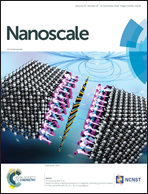Fluorescent 2D metal–organic framework nanosheets (MONs): design, synthesis and sensing of explosive nitroaromatic compounds (NACs)†
Abstract
2D metal–organic framework nanosheets (MONs) lie at the heart of contemporary research on metal–organic materials. We have rationally designed and synthesized a fluorescent 6-connecting hexaacid linker H6TPA based on the 1,3,5-triphenylbenzene core to access layered MOFs by metal-assisted self-assembly. Treatment of H6TPA with In3+ salt does indeed lead to a layered porous MOF, i.e.In-TPA. It is shown that the ultrasonication-induced liquid phase of exfoliation (UILPE) of the latter in a top-down fashion affords few-layer 2D metal–organic nanosheets (MONs). The delamination of 2D MONs in ethanol occurs with ‘turn-on’ fluorescence, which is otherwise suppressed in the bulk material. The exfoliated MONs in ethanol exhibit blue fluorescence with a respectable quantum yield of 0.15 and serve as efficient sensory materials for ‘turn-off’ fluorescence detection of explosive nitroaromatic compounds (NACs). While all nitroaromatics are found to quench the fluorescence of MONs, the most electron-deficient trinitrotoluene (TNT) exhibited the highest efficiency; at 2 mM concentration of TNT, the fluorescence of 2D MONs was found to be quenched with an efficiency of 80% (permitting the detection of TNT at ca. 11 ppm level), while that of the unmetallated linker, i.e.H6TPA, was quenched with only 5% efficiency. The unique attributes of MONs, namely the rigidity of the linker upon metallation and porosity that facilitates guest confinement within the pores, for efficient sensing of nitroaromatics are thus demonstrated for the first time.



 Please wait while we load your content...
Please wait while we load your content...